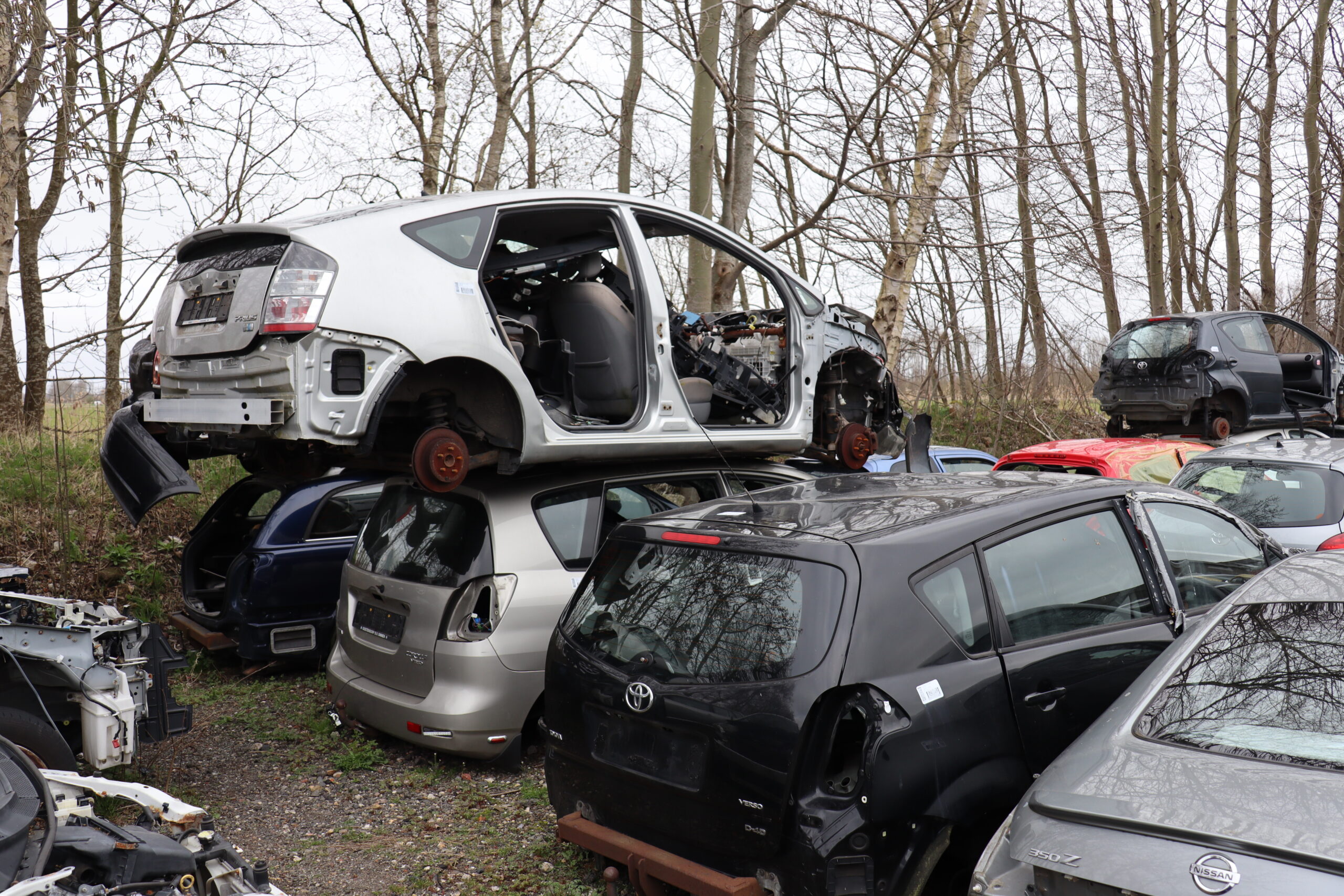In the Post Shredder Technology (PST) plant in Tiel, ARN recovers the last bits of valuable raw materials from the post-shredder waste that remains after car recycling. This process is so advanced that it even involves attention for miniscule quantities of Substances of Very High Concern (SVHC). These substances are bad for people and the environment and may impede the optimum recycling of waste flows.
Tekst Jens Holierhoek
When a car reaches the end of its useful life, after some eighteen years on average, it enters the car recycling chain and moves through each stage of the recycling process. Hazardous waste materials are removed, usable parts are stripped and useful materials are sold on. The remainder of the car, for which there is no immediate purpose, goes into a shredder to be crushed into small pieces. What remains – in the Netherlands, about seventeen per cent of the car’s total weight – then makes its way to the PST plant in Tiel. Since 2011, the groundbreaking PST has been used here to sort post-shredder waste for recycling. This is because, on closer examination, the seemingly worthless post-shredder waste still contains a great deal of value in the form of minerals, fibres, plastic and metals. Via four main flows, these remnants are upgraded into new, usable raw materials. And some surprising figures make it clear just how efficiently ARN does this. Of the 40,000 tons of waste processed annually by the PST plant, over 40 per cent is given a new life as reusable material.
Scary substancesThe advanced technology and special care demonstrated by the plant in the Betuwe region is evident not only in the large number of machines and technologies they use. In the PST plant, strict attention is also paid to what are known as Substances of Very High Concern (SVHC). These are substances which, according to the Netherlands National Institute for Public Health and the Environment (RIVM), are hazardous to people and the environment. They may, for instance, be carcinogenic or have a negative impact on fertility. In short, they are substances that (in excessive concentrations) are undesirable in a recycled product.Because many of the cars processed in Tiel are older models, it is not unusual for SVHCs to be present in the material. Fortunately, hardly any PCBs are encountered nowadays; these compounds have been prohibited for use in cars since 1985. In the past, these polychlorinated biphenyls were used in the car industry because of their stable chemical properties and heat-resistant nature – yet they are also toxic and potentially carcinogenic. Another SVHC commonly found in cars, are flame retardant materials. When incorporated into plastics and seat coverings, these materials save many lives – but there is simply no place for them in waste flows and recycled products. The bromide from the flame retardants is toxic to humans.
Proper preparationThe post-shredder waste that arrives at the PST plant in Tiel has been free of PCBs for some time. All fluids that might contain them are drained and processed at an earlier stage of the recycling process. “In only a few years’ time, PCB levels have shown a significant drop. One reason for this is that cars are becoming cleaner thanks to stricter regulation of car manufacturers – and at the same time, the recycling process has continued to improve as well,” explains Marcel van der Veer, Quality Manager at the PST plant.
These days, the post-shredder waste that arrives at the PST plant in Tiel is PCB-free
Still, a solution for some flame retardant materials has yet to be found. “There are a few plastic waste flows where we regularly encounter flame retardant material. Even if it’s only a limited concentration – we’re talking about parts per million here – the levels in some material flows are still high enough to preclude any further processing and recycling.” The material flows in question are incinerated and the resulting energy is recovered. With regard to incineration, ARN complies with the guidelines in the National Waste Management Plan (LAP3) to ensure that no hazardous substances are released at this stage either.
Flame retardantsThe fact that precision required to process waste flows containing SVHCs is demonstrated by the way the plant handles one specific flame retardant known as decabromodiphenyl ether, or decaBDE. While this brominated flame retardant has been prohibited in new products since 2017, it is still commonly found in cars handed in for recycling. The idea was, as per the recommendation of German government agencies, to send all car parts containing decaBDE to the incinerator in the post-recycling phase. While on paper, this may have appeared to be a logical step, this approach was revealed to be rather indiscriminate in practice, according to Janet Kes, Manager of Corporate and Public Affairs at ARN. “For us, the incinerator is a last resort. Our goal, after all, is to recycle at least 95 per cent of every car wreck. If we start burning all suspicious parts immediately and in full, this percentage is in danger of becoming unattainable. And besides, in some cases it’s perfectly acceptable to reuse these materials – provided the allowable concentration is not exceeded. What’s more, the manual dismantling of all those parts requires a huge amount of work, as they’re scattered throughout the entire vehicle.”
“We work based on hunches. Then we check the REACH database to see if any restrictions apply to specific materials”
It’s also possible, Kes says, for the use of decaBDE to differ drastically from one brand and type of car to another. The use of manual labour also means the processing costs are sky-high, while there are no guarantees that the method actually reduces the risks. “At the behest of the automotive industry, we explored whether a recycled product will actually contain a dangerous level of decaBDE. For instance, we participated in a study commissioned by the ACEA [the European Association of Auto Manufacturers] and carried out by the independent Öko Institute in Germany. And as it turns out: the products don’t! The critical threshold of 0.001 per cent by weight, or ten milligrams per kilo, is not exceeded by the material flows that are currently being used in new products or applications.”
Other material flows, however, do exceed the allowable level. As Marcel van der Veer already mentioned, these materials are incinerated and the resulting energy is recovered.
REACHWhile it would of course be good if every waste flow were subjected to this type of independent, in-depth investigation, such a measure is not feasible when you realise that the list of Substances of Very High Concern has some 1,500 entries. “We work based on hunches,” Van der Veer says. Then we check the REACH database to see if any restrictions apply to specific materials.” REACH, which stands for the Registration, Evaluation and Authorisation of Chemicals, encompasses European legislation concerning the entire journey from car manufacturer to recycling and the post-shredder phase. The REACH directive establishes rules with which businesses and governments must comply with regard to handling chemical substances. For instance: according to these provisions, car manufacturers must identify all chemicals they incorporate into their vehicles. These substances can in turn be found in the REACH database. In the PST plant, ARN frequently deals with directives on POPs as well. POP stands for Persistent Organic Pollutant; flame retardant materials are one example of such a pollutant.
Greater transparencyDespite the REACH directive, tracing SVHC remains a difficult undertaking. Janet Kes concurs: “It’s a constant challenge to figure out exactly which materials contain SVHC, as post-shredder waste naturally contains a mix of materials. And manufacturers are dependent on suppliers, who in turn have other companies that supply them.”
Marcel van der Veer sees yet another potential obstacle. “All things considered, we’re lagging about eighteen years behind reality. The cars that come to us are old and were built before the current stricter legislations and rules came into effect,” he explains. Still, the quality manager sees much cause for optimism. “Fortunately, car manufacturers are open to improving the recycling options for their models. Leading car brands regularly ask us what they can do and how they can improve their use of materials. Car manufacturers want to learn, and that is positive.”
Open dialogueIt is precisely because of its specialised nature that car manufacturers frequently and eagerly choose to do business with the PST plant in Tiel. This also provides ARN with an opportunity to address the desired changes with regard to how their cars are recycled. Janet Kes: “We like to be open about whatever challenges we encounter. Ultimately, we in the recycling industry are only a small link in a much larger chain. Car manufacturers must comply with an incredible number of rules and regulations, and recycling is one of those.” She points out that car manufacturers tend to consider the big picture when choosing which materials to use. “They select their materials based on aspects such as safety and emissions standards during the car’s useful life, as opposed to on the basis of what happens after that useful life has ended.” Kes gives an example: the catalytic converter. “It’s a great invention for reducing harmful emissions while driving, but it also poses a challenge to recyclers in that it requires highly advanced technology to process. In other words, the environmental ‘profit’ during the car’s useful life outweighs the environmental impact when it is ultimately recycled.”
*The interviews with Van der Veer and Kes were conducted in February 2019.



